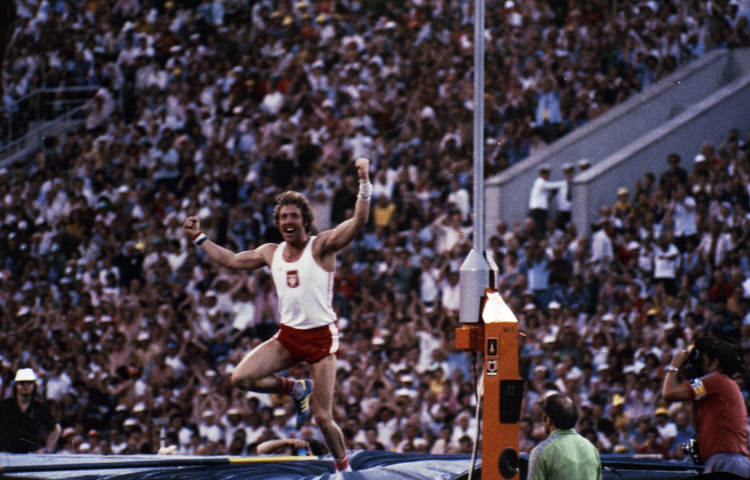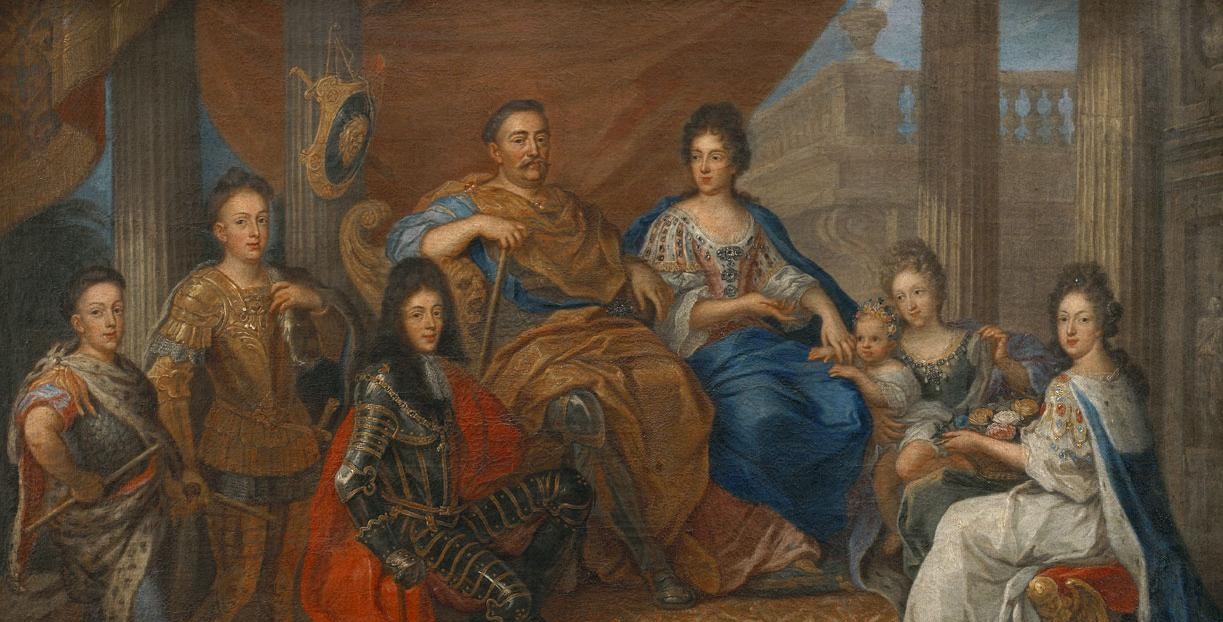On July 30, 1980, during the Olympic Games in Moscow, Władysław Kozakiewicz won the pole vault competition. Apart from setting the world record (5.78 m), which to this day sets him among the leaders of this competition, the athlete is also remembered for an unsportsmanlike gesture he gave the hostile audience – the bras d’honneur.
by Piotr Bejrowski
Seven months prior, on December 25, 1979, the Soviet authorities announced their military intervention in response to a request for support from the Afghan government (known as the Afghan War 1979-1989). The United States immediately opposed this invasion, and President Jimmy Carter announced a set of sanctions and called for a boycott of the Summer Games. It had been a challenging election year for the Democratic president following the revolution in Iran, the fall of the Shah, and the detention of the American hostages at the embassy in Tehran. He needed a foreign policy win. Carter’s advisors put pressure on the International Olympic Committee, demanding the cancellation or relocation of the Olympics. However, they were reminded that an Olympics Games had taken place [in the US] during the Vietnam War. Ultimately, the boycott served as a demonstration of American values and garnered from nearly three-quarters of Americans. Over sixty invited countries, including the USA, Canada, Japan, Israel, China, Norway, and West Germany, chose not to participate in the sports competition. Despite pressure from Prime Minister Margaret Thatcher, British athletes decided to compete in Moscow.
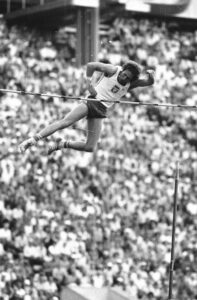
Simultaneously with the Olympics, in Poland, a country that was part of the Eastern bloc and served as a transit country for many football fans, a special operation by the intelligence services under the code name “Moscow ’80” was underway. The operation involved monitoring foreign guests and groups that could interact with them, including those who provided illegal services such as accommodation, food, and sexual services. Ministry of the Interior employees also accompanied Polish tours heading to the Soviet capital. Records were kept of those who supported the opposing team in matches against the host nation. Meanwhile, posters prepared by the pre-Solidarity opposition appeared on city streets in Poland comparing the Olympics in Berlin and Moscow. These posters depicted the Olympic circles, symbolizing the Games, as part of a tank gun barrel.
With a team of 325 athletes, Poland boasted the second-largest representation at the Olympics and was surpassed only by the Soviet Union. Despite winning a record number of 32 medals, the athletes competing under the white and red flag were disappointed to receive only three gold medals. This outcome fell short of their performance at Montreal’s “full team” Olympics. On the top of the podium stood: Bronisław Malinowski (3000m steeplechase) following a beautiful run and victory over the competition, Jan Kowalczyk in the horse jumping competition (the first Polish medal in this activity since 1945), and the well-remembered Władysław Kozakiewicz, who was eventually award recognition as the Polish athlete of the year in the prestigious “Przegląd Sportowy” poll.
The athlete, born on December 8, 1953, came from a family of Lithuanian Poles near Vilnius. The first three and a half years of his life were spent in the Soviet Union, an aspect that was repeatedly criticized despite his apparent aversion towards the “big brother.” Eventually, his family was repatriated to Gdynia, where Kozakiewicz began training. While under twenty-three, he participated in his first Olympics. Unfortunately, a foot injury prevented him from fighting for top positions in Montreal, resulting in an 11th-place finish.
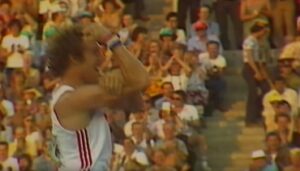
In Moscow, Kozakiewicz was marked as a favorite following previous success as a multiple medalist of the European Championships (the World Championships were not held at that time). He competed for victory against Konstantin Wołków of the host nation (who finished in third place) and Tadeusz Ślusarski, the Polish gold medalist from four years prior and eventual winner of silver in 1980. Despite being booed by the audience, Kozakiewicz cleared a height of 5.75m on his first attempt, which was followed by the expressive gesture that would forever be remembered. No other competitor managed to surpass this height. Then, with his victory all but assured, the gold medalist capitalized on his next attempt, defiantly concluding the sporting battle by setting a new world record (5.78m).
Polish newspapers deliberately omitted any mention of Kozakiewicz’s gesture. In fact, the Communist party’s newspaper “Trybuna Ludu” went so far as to falsely claim that the pole vaulter “bowed low to the ground to the tribunes for joy.” At a meeting with the medalists, Polish Prime Minister Edward Babiuch declared that “the forces seeking to undermine the importance of the Moscow Olympics have been utterly defeated.” Despite the crisis growing in the country, tables were set with caviar and sausages. However, the car vouchers promised to the best athletes never materialized. It was August 1980. A few days later, the Olympic spirit became of little importance when a strike broke out in the Gdańsk Lenin Shipyard, setting in motion historical changes in the part of Europe under Moscow’s dominance.
In 1984, the Soviet Union decided to boycott the Los Angeles Olympic Games. Instead, athletes from the Eastern Bloc met at the Friendship ’84 competition. Kozakiewicz, who had wanted to compete in the Olympics, once again displayed anti-Russian behavior. He jumped a single height in Moscow, expressed his gratitude, and left the stadium. A year later, Kozakiewicz permanently relocated to Germany and was swiftly branded a traitor. The circumstances of the departure, however, were complicated and, like the repatriation from the Soviet Union to Poland, were a sign of the times. With the shift in borders, some Poles found themselves residing within the territory of the Soviet Union. Wladyslaw Komar, the Olympic champion in the shot put in 1972, was born in Kaunas. Kozakiewicz’s departure was primarily motivated by a desire to earn more money, and once the authorities dismissed him, he decided to take German citizenship and compete under the German flag. Despite the circumstances surrounding his departure, his victory in Moscow and his attitude during the competition remain embedded in the collective memory of the Polish people.
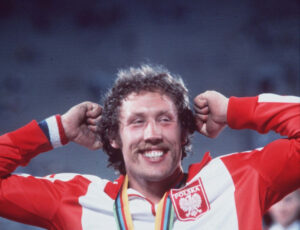
Władysław Kozakiewicz’s performance at the Olympics was undeniably one of the most remarkable achievements in Polish participation in the Games. Although the athlete faced criticism from activists, his compatriots watched the competition on television and unequivocally embraced this gesture on the eve of the strikes.
Of course, Kozakiewicz’s gesture was not the first instance of anti-Soviet sentiment following a Polish victory in sports. On October 20, 1957, at the packed Silesian Stadium in Chorzów, the Polish football team faced the Soviet Union in a World Cup qualifier match. Despite being the reigning Olympic champions, the Soviets unexpectedly suffered a 2-1 defeat. Gerard Cieślik scored twice against the legendary Lev Yashin, the only goalkeeper in history to be awarded the Golden Ball. During the match, considered one of the most critical matches in Polish football history, 100,000 spectators sang the Polish national anthem and the country’s celebratory birthday song, “Sto lat” (meaning “A Hundred Years”) for the footballers.
Author: Piotr Bejrowski
Translation: Alicja Rose & Jessica Sirotin

